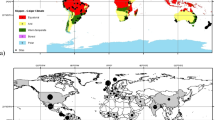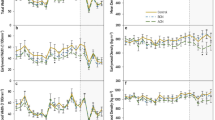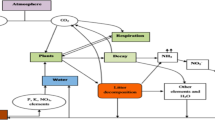Abstract
The recent expansion of Phragmites australis (common reed) from the marsh-upland interface into high marsh zones provides an opportunity to assess the impact of individual plant species on biomass production and decomposition in salt marshes. Seasonal harvests of aboveground and belowground biomass demonstrate that annual production of P. australis is approximately three times greater for aboveground biomass, two times greater for belowground biomass, and 30% lower in root: shoot ratio than neighboring populations of S. patens. Whole-plant litter (stems and leaves) also decomposes at a much slower annual rate for P. australis (k=0.25) than S. patents litter (k=0.57). By crossing litter type with site of litter decomposition, I found these plant species to influence decay rates through litter type and not through their effects on marsh surface conditions (e.g., temperature, sedimentation rates). Based on these calculations, annual rates of carbon accumulation in the peat of high marshes are likely to increase 5-fold once P. australis becomes established due to its greater rates of biomass production and residence time in infrequently flooded brackish marshes.
Similar content being viewed by others
Literature Cited
Abacus Concepts. 1996. Statview 4.1. Abacus Concepts, Inc. Berkeley, CA, USA.
Amsberry, L., M. A. Baker, P. J. Ewanchuk, and M. D. Bertness. 2000. Clonal integration and the expansion of Phragmites australis. Ecological Applications 10:1110–1118.
Armstrong, J. and W. Armstrong. 1991. A convective through-flow of gases in Phragmites australis (Cav.) Trin. ex Steud. Aquatic Botany 39:75–88.
Bertness, M. D. 1991. Interspecific interactions among high marsh perennials in a New England salt marsh. Ecology 72:125–137.
Bertness, M. D. and A. M. Ellison. 1987. Determinants of pattern in a New England salt marsh community. Ecological Monographs 57:129–147.
Blum, L. 1993. Spartina alterniflora root dynamics in a Virginia marsh. Marine Ecology Progress Series 102:169–178.
Brinson, M. M., A. E. Lugo, and S. Brown. 1981. Primary productivity, decomposition, and consumer activity in freshwater wetlands. Annual Review of Ecology and Systematics. 12:123–161.
Chambers, R. M. 1997. Porewater chemistry associated with Phragmites and Spartina in a Connecticut tidal marsh. Wetlands 17: 360–367.
Dacey, J. W. H. and B. L. Howes. 1984. Water uptake by roots controls water table movement and sediment oxidation in short Spartina marsh. Science 224:487–489.
Ferren, W. R., Jr., R. E. Good, R. Walker, and J. Arsenault. 1981. Vegetation and flora of Hog Island, a brackish wetland in the Mullica River, New Jersey. Bartonia 48:1–10.
Frasco, B. A. and R. E. Good. 1982. Decomposition dynamics of Spartina alterniflora and Spartina patens in a New Jersey salt marsh. American Journal of Botany 69:402–406.
Gallagher, J. L. 1978. Decomposition processes: summary and recommendations. p. 145–151. In R. E. Good, D. G. Whigham, and R. L. Simpson (eds.) Freshwater Wetlands: Ecological Processes and Management Potentials. Academic Press, New York, NY, USA.
Halupa, P. J. and B. L. Howes. 1995. Effects of tidally mediated litter moisture content on decomposition of Spartina alterniflora and S. patens. Marine Biology 124:379–384.
Haslam, S. M. 1972. Biological flora of the British Isles no. 128: Phragmites communis Trin. Journal of Ecology 60:585–610.
Hietz, P. 1992. Decomposition and nutrient dynamics of reed (Phragmites australis (Cav.) Trin ex Steud.) litter in Lake Neusiedl, Austria. Aquatic Botany 43:211–230.
Hobbie, S. 1992. Effects of plant species on nutrient cycling. Trends in Ecology and Evolution 7:213–216.
Hooper, D. U. and P. M. Vitousek. 1998. Effects of plant composition and diversity on nutrient cycling. Ecological Monographs 68:121–149.
Howes, B. L., J. W. H. Dacey, and D. D. Goehringer. 1986. Factors controlling the growth form of Spartina alterniflora: feedbacks between aboveground production, sediment oxidation, nitrogen and salinity. Journal of Ecology 74:882–898.
Howes, B. L., R. W. Howarth, J. M. Teal, and I. Valiela. 1981. Oxidation-reduction potentials in a saltmarsh: Spatial patterns and interactions with primary production. Limnology and Oceanography 26:350–360.
Lee, S. Y. 1990. Net aerial primary productivity, litter production and decomposition of the reed Phragmites communis in a nature reserve in Hong Kong management implications. Marine Ecology Progress Series 66:161–173.
Lissner, J. and H. H. Shierup 1997. Effect of salinity on the growth of Phragmites australis. Aquatic Botany 55:247–260.
Marinucci, A. C. and R. Bartha. 1982. A component model of microbial decomposition in a New Jersey salt marsh. Canadian Journal of Botany 50:1618–1624.
Mason, C. F. and R. J. Bryant. 1975. Production, nutrient content, and decomposition of Phragmites communis Trin. and Typha angustifolia L. Journal of Ecology 63:71–95.
Matsushita, N. and T. Matoh, 1991. Characterization of Na+ exclusion mechanisms of salt-tolerant reed plants in comparison with salt-sensitive rice plants. Physiologica Planta. 83:170–176.
Meyerson, L. A., R. M. Chambers, and K. A. Vogt. 2000. The effects of Phragmites removal on nutrient pool in a freshwater tidal marsh ecosystem. Biological Invasions, 1:129–136.
Miller, W. R. and F. E. Egler. 1950. Vegetation of the Wequetequock-Pawcatuck tidal marshes, Connecticut. Ecological Monographs. 20:143–172.
Miller, W. R. and F. E. Egler. 1950. Vegetation of the Wequetequock-Pawcatuck tidal marshes, Connecticut. Ecological Monographs. 20:143–172.
Orson, R. A. 2000. A paleoecological assessment of Phragmites australis in New England tidal marshes: changes in plant community structure during the last few millenia. Biological Invasions 1:149–158.
Rooth, J. and C. Stevenson. 2000. Sediment deposition patterns in Phragmites australis communities: Implications for coastal areas threatened by rising sea-level. Wetlands Ecology and Management 8:173–183.
Teal, J. M. 1962. Energy flow in the salt marsh ecosystem of Georgia. Ecology. 43:614–624.
Valiela, I., B. Howes, R. Howarth, A. Giblin, K. Foreman, J. M. Teal, and J. E. Hobbie. 1980. Regulation of primary production and decomposition in a salt marsh ecosystem. p. 151–168. In Wetlands: Ecology and Management. Proceedings of the First International Wetlands Conference, New Delhi, India.
Wainright, S. C., M. P. Weinstein, K. W. Able, and C. A. Currin 2000. Quantitative importance benthic microalgae, phytoplankton, and the detritus of smooth cordgrass (Spartina) and the common reed (Phragmites) to brackish marsh food webs. Marine Ecology Progress Series. 200:77–91.
White, D. A. and J. M. Trapani. 1982. Factors influencing the disappearance of Spartina alterniflora from litterbags. Ecology 63: 242–245.
White, D. A., T. E. Weiss, J. M. Trapani, and L. B. Thien. 1984. Productivity and decomposition of the dominant salt marsh plants in Louisiana. Ecology 59:751–759.
Windham, L. 1999. Effects of an invasive reedgrass, Phragmites australis, on nitrogen cycling in brackish tidal marshes of New York and New Jersey. Ph.D. Thesis. Rutgers University, New Brunswick, NJ, USA.
Windham, L., and R. G. Lathrop, Jr. (1999). Effects of Phragmites australis on aboveground biomass and soil properties in brackish tidal marsh. Estuaries 22:927–935.
Author information
Authors and Affiliations
Corresponding author
Rights and permissions
About this article
Cite this article
Windham, L. Comparison of biomass production and decomposition between Phragmites australis (common reed) and Spartina patens (salt hay grass) in brackish tidal marshes of New Jersey, USA. Wetlands 21, 179–188 (2001). https://doi.org/10.1672/0277-5212(2001)021[0179:COBPAD]2.0.CO;2
Received:
Revised:
Accepted:
Issue Date:
DOI: https://doi.org/10.1672/0277-5212(2001)021[0179:COBPAD]2.0.CO;2




